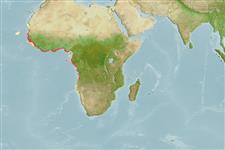Common names from other countries
Élasmobranches (requins et raies) (sharks and rays) >
Carcharhiniformes (Ground sharks) >
Leptochariidae (Barbeled houndsharks)
Etymology: Leptocharias: Etymology not explained, perhaps leptos (Gr.), slender; [Car]charias, i.e., a slender shark “very nearly related to Carcharias”. (See ETYFish); smithii: In honor of Andrew Smith (1797-1872), Scottish military physician, explorer, ethnologist and zoologist, who collected many South African sharks and coined many of the shark names later used by Müller and Henle. (See ETYFish).
More on authors: Müller & Henle.
Environment: milieu / climate zone / depth range / distribution range
Écologie
marin; saumâtre démersal; profondeur 10 - 75 m (Ref. 244), usually 10 - 60 m (Ref. 5377). Tropical; 20°C - 27°C; 22°N - 23°S, 26°W - 17°E
Eastern Atlantic: Mauritania to Namibia (Ref. 127434).
Taille / Poids / Âge
Maturity: Lm ? range ? - ? cm
Max length : 77.0 cm TL mâle / non sexé; (Ref. 244); 82.0 cm TL (female); common length : 55.0 cm TL mâle / non sexé; (Ref. 26999)
Description synthétique
Clés d'identification | Morphologie | Morphométrie
Similar to species of Mustelus but nostrils with anterior flaps formed into distinct barbels (Ref. 5485).
Found on the continental shelf, especially abundant off river mouths on muddy bottoms. Salinity: 35-36 ppt. Oxygen: 3-4 ppm. Feeds on small bottom and littoral organisms like crustaceans, bony fishes, octopi and sponges. Viviparous (Ref. 50449), with 7 young in a litter (Ref. 244). Dental sexual dimorphism is manifested by males having greatly enlarged anterior teeth. Utilized fresh, smoked or dried salted for human consumption, skin for leather.
Life cycle and mating behavior
Maturities | Reproduction | Spawnings | Egg(s) | Fecundities | Larves
Viviparous, placental (Ref. 50449), with 7 young in a litter (Ref. 244). Distinct pairing with embrace (Ref. 205).
Compagno, L.J.V., 1984. FAO Species Catalogue. Vol. 4. Sharks of the world. An annotated and illustrated catalogue of shark species known to date. Part 2 - Carcharhiniformes. FAO Fish. Synop. 125(4/2):251-655. Rome: FAO. (Ref. 244)
Statut dans la liste rouge de l'IUCN (Ref. 130435)
CITES (Ref. 128078)
Not Evaluated
Menace pour l'homme
Harmless
Utilisations par l'homme
Pêcheries: intérêt commercial mineur
Outils
Articles particuliers
Télécharger en XML
Sources Internet
Estimates based on models
Preferred temperature (Ref.
115969): 19.2 - 28, mean 26 (based on 116 cells).
Phylogenetic diversity index (Ref.
82804): PD
50 = 1.5000 [Uniqueness, from 0.5 = low to 2.0 = high].
Bayesian length-weight: a=0.00389 (0.00180 - 0.00842), b=3.12 (2.94 - 3.30), in cm Total Length, based on all LWR estimates for this body shape (Ref.
93245).
Niveau trophique (Ref.
69278): 3.8 ±0.49 se; based on food items.
Résilience (Ref.
120179): Très faible, temps minimum de doublement de population supérieur à 14 ans (Fec=7).
Fishing Vulnerability (Ref.
59153): Moderate to high vulnerability (53 of 100).
